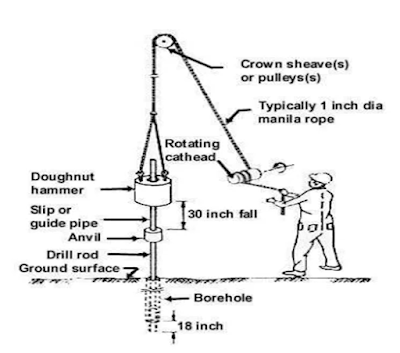Foundations are basically of two (02) types:
1) Shallow Foundation
i. Isolated Footing
ii. Combined Footing
iii. Strap Footing
iv. Mat or Raft Footing
v. Wall Footing
2) Deep Foundation
i. Pile Foundation
ii. Pier Foundation
iii. Well Foundation.
What is Shallow Foundation?
Answer: According to Terzaghi, if the depth of foundation is less than or equal to its width, then it is called a Shallow Foundation. This type of foundation transfer building load to the earth very near to the surface.
What is Deep Foundation?
Answer: According to Tarzaghi, if the depth of foundation is greater than its width. then it is called Deep Foundation. A deep foundation is generally much more expensive than a shallow foundation.
Why Lapping is provided in Reinforcement?
Answer: Steel reinforcement has a limitation in length, usually it is 12.00 meter in length. So in case of RCC structure, placing of a single bar may not meet the required length of the section and it becomes necessary to join two bars, to meet the desire length. To join two bars, one bar should overlap another and it is called lapping of bar and the length overlap each other is caller lap length or overlap length.
Where is the Lapping Zone for Column?
Answer: For column the lapping zone is middle portion of the column, because the L/4 distance from both support of the column experienced much tension and at the middle point the tension is zero. Since, middle portion experience less tension so it is safe to provide lapping in middle section.
Answer: In case of beam, for top reinforcement mid section don't experience any negative moment so it is the safe zone for lapping. For bottom reinforcement, lapping is provided near the end of the beam or L/4 distance from column face.
What is Clear Cover?
Answer: Clear cover can be defined as the clear distance between the surface of the concrete and surface of the rebar.
Why clear cover is provided?
Answer: Clear cover is provided to protect the reinforcement from the phenomenon called corrosion and to provide fire resistance to bars embedded in concrete.
What are the classification of pile foundation?
Answer: Types of Pile Foundation can be classified based on
(1) Material used
i) Steel Piles
ii) Concrete Piles
iii) Timber Piles
iv) Composite Piles.
(2) Mode of transfer of load
i) End Bearing Piles
ii) Friction Piles
iii) Combined end bearing and Friction Piles.
(3) The use
i) Load Bearing Piles
ii) Compaction Piles
iii) Tension Piles
iv) Sheet Piles
v) Fender Piles
vi) Anchor Piles.
(4) Method of Installation
i) Driven Piles
ii) Driven and Cast-in-Situ Piles
iii) Bored and cast-in-Situ Piles
iv) Jacked Piles
v) Screw Piles.
(5) The Displacement of Soil.
i) Displacement Piles.
ii) Non-Displacement Piles.
What is segregation of concrete?
Answer: Segregation may be defined as the separation of the constituent materials of concrete from homogeneous mix.
Causes of Segregation?
Answer: Followings are the main cause of segregation
1) The root cause of segregation is difference in specific gravity and size of its constituent material.
2) Improper grading of aggregates.
3) Too much vibration during concreting.
4) Improper handling of aggregates.
5) High water cement ratio in concrete. Adding excess water while mixing concrete may lead to segregation.
6) Placing of concrete from a greater height, etc.
How to prevent segregation of concrete?
Answer: Segregation can be prevent by following way:
1) Aggregate should be properly graded to prevent segregation.
2) Maintain proper water cement ratio.
3) At the time of placement care should be taken that the concrete is not poured from a height greater than 1.5 meter.
4) Care should be taken during compaction ( specially for compaction using mechanical vibrator).
5) To improve viscosity of concrete which prevent segregation, air entraining agents may use.
What is worability of concrete?
Answer: Workability of concrete can be defined as, the easy with which the concrete ingredients can be mixed, transported, placed, compacted and finished with minimum homogeneity loss.
What are the Importance of workability of concrete?
Answer: Any concrete mixture needs to be sufficiently workable to be properly placed and consolidated with the available procedures to fill the forms completely and surround the reinforcement and other embedded item.
What are the factor affecting workability of concrete?
Answer: Factors Affecting Workability of Concrete:
1) Water content at concrete mix
2) Quantity of cement and its property
3) Gradation of Aggregate
4) Humidity of Environment
5) Mode of Compaction.
6) Method of Mixing
7) Method of transmission
8) Method of Placement
9) Weather Condition etc.
How to determine workability of concrete?
Answer: Workability of concrete can be determine by:
1) Slump test method.
2) Vee-Bee test method.
3) Compaction factor test.
How to measure workability of concrete at field?
Answer: Slump test is used to determine the workability of concrete at construction site.
What are the procedure for slum test?
Answer: Procedure:
1) The base should placed on a smooth surface and the cone will filled in three (03) layer with concrete.
2) Each layer have to temped 25 times with temping rod.
3) After filling the mould, excess concrete should be removed and the surface should be leveled. When the mould will filled fresh concrete, the base of the mould will held firmly by handles.
4)Then the mould will lifted gently in the vertical direction and then unsupported concrete will slump. The decrease in height at the center point is measured to nearest 5 mm or 0.25 inch and it is known as "slump".
What are the types of Slump?
Answer: Types of Concrete Slump:
1) True Slump: In a true slump concrete just subsides shortly and more or less maintain the mould shape. This type of slump is most desirable.
2) Shear slump: If one-half of the cone slides down in an inclined plane, it is called a shear slump. Shear slump indicates lack of cohesion in the concrete mix. Shear slump may occur in the case of a harsh mix.
3) Collapse slump: In this case, fresh concrete collapses completely.
What are the field test of cement?
Answer: Field tests of cement are:
1) Manufacturing Date: As strength of cement reduced with time, so checking of manufacturing date is very important.
2) Colour of Cement: Colour of cement should be uniform and it would be light greenish gray.
3) Presence of Hard Lump: Presence of lump in cement bag indicates the moisture absorption. So it should be free from lump.
4) Temperature: Temperature of cement in bag is very important. Normally if someone enter his hand in a cement bag it will feel cool. But if it feel worm, ( but new cement from the manufacturing will be warm) then it indicate that hydration reaction start there, which is not desired.
5) Smoothness: When cement rubbed with two fingers it will feel smooth. Rough in feelings indicate adulteration.
6) Water Sinking: If a small quantity of cement thrown on water in-case of good quality cement it will sink.
7) Flexure Test: Make a 25 mm * 25 mm * 200 mm block if cement with water. Then immersed in water for 03 days. After removing, it is supported 150 mm apart and a weight of 15 kg uniformly placed over it. If it shows no sign of failure, the cement is good.









